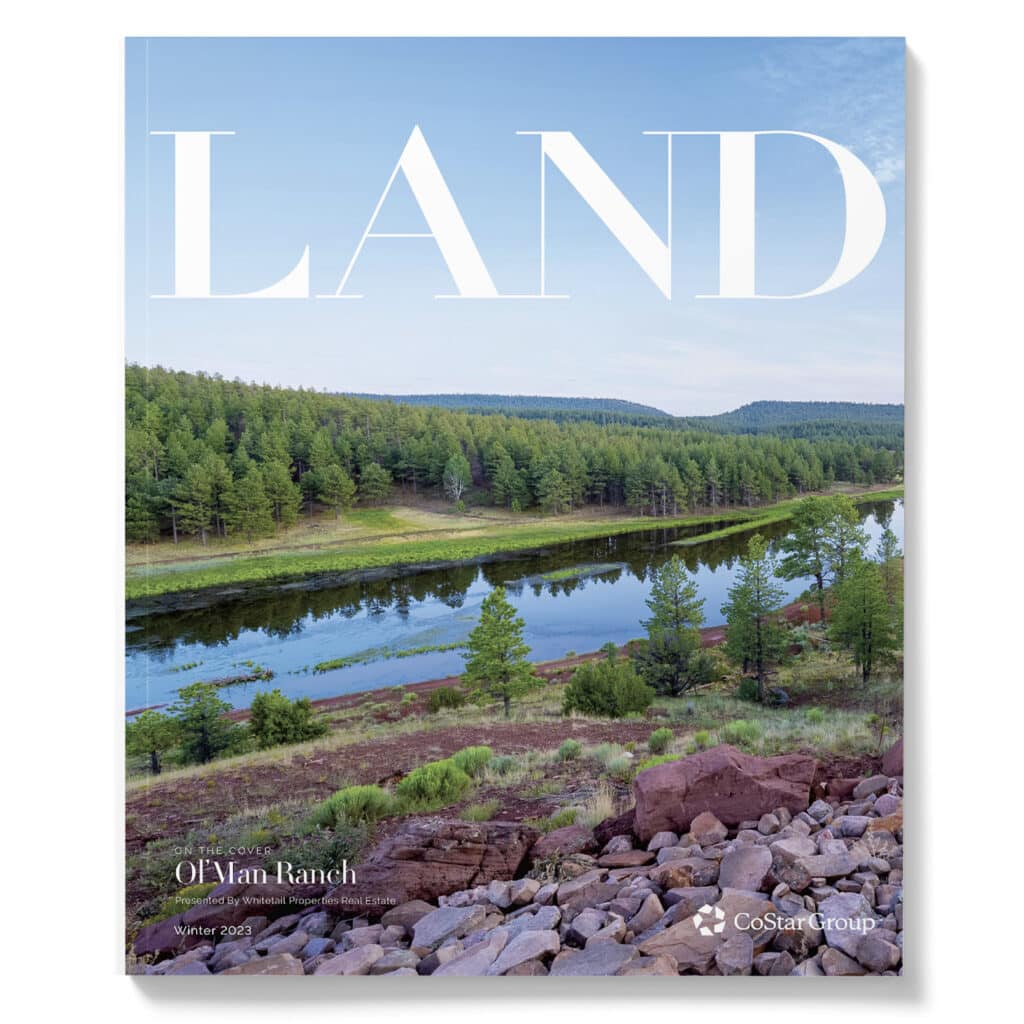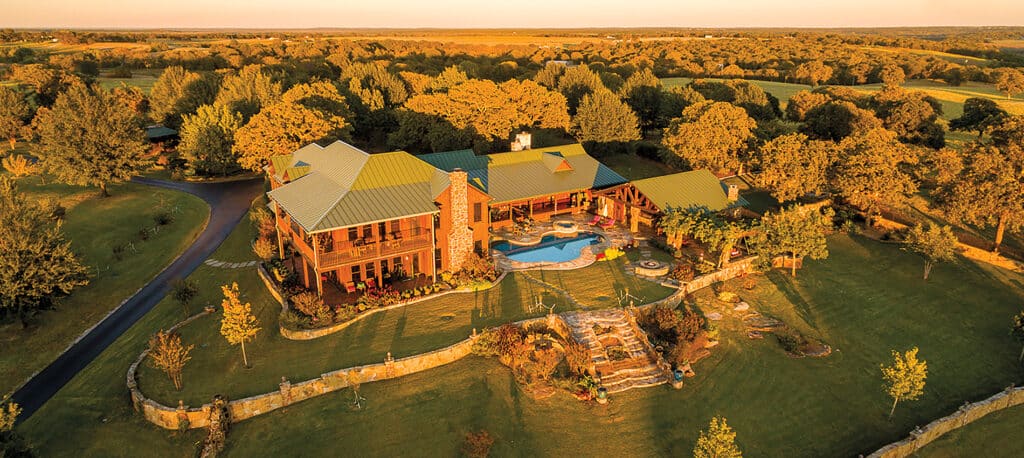
This article is featured in the Winter 2023 issue of LAND magazine. Click here to find out more.
The once-frenzied market for ranches may have cooled this year, but deals are still getting done as older landowners look to part with their wide open spaces.
Just ask NFL legend Terry Bradshaw. The former professional football star quarterback and his wife spent more than five years marketing their nearly 800-acre ranch just north of the Red River in Oklahoma, listing it for $22.5 million, before selling it this year for an undisclosed sum.
He just didn’t have the time to run a horse ranch like he once did, Bradshaw said. The buyer is a partnership that is rebranding the property as Red River Equine and developing a large-scale American Quarter Horse breeding and training facility.
Bradshaw is part of a generation of ranch owners taking advantage of rising valuations in recent years by seeking to either turn over the family ranch to a new generation or sell it to another legacy owner wanting to carry on the traditions of the American West. But what once was a surge of properties trading hands throughout the southwest United States and Texas has now slowed, as high interest rates and rising property valuations keep some buyers at bay.
Longtime ranch broker Sam Middleton’s firm brought in over $1 billion in sales 2022 with the Four Sixes Ranch selling to a group led by “Yellowstone” creator Taylor Sheridan and the sale of the late oil tycoon T. Boone Pickens’ ranch in West Texas to energy investor Bill Kent. This year, there’s been fewer such blockbusters.
“We are coming back to a more normal situation,” Middleton, owner of Chas. S. Middleton and Son, which specializes in ranch appraisals and sales, told CoStar News. “Buyers today are more selective after a crazy few years that didn’t make sense. The better properties are still getting sold, but there’s not that frenzied market.
“Still, new ranches continue to come to market, often as families consider their future, said James King, director of King Land & Water, a Texas ranch broker.
“If four families inherit a ranch that supported one family, it becomes harder to support families on that same ranch,” King told CoStar News. “One major piece to that puzzle is land prices have gone up enormously in value in Texas over the last several decades. These families could be sitting on assets worth millions of dollars when they are only producing tens of thousands of dollars a year.
One major piece to that puzzle is land prices have gone up enormously in value in Texas over the last several decades.
“The economics are too enticing, and they often will choose to sell the land to have, for example, $5 million in a lump sum instead of making $100,000 a year in income,” he added. In Texas, on average, King said land values have risen six percent annually over the past 40 years and are expected to keep climbing.
Preserving History
The ranch trade was popularized decades ago when billionaire Ted Turner, founder of the cable television colossus CNN, began buying ranches to preserve open spaces in the United States. He is one of the nation’s largest landowners of ranch and private land.
The investment ended up being a sound financial decision as land values soared—enticing other high-net-worth individuals, families and companies to follow suit, said Tyler Jacobs, director and real estate partner at Hall and Hall.
Jacobs, based at the firm’s branch in College Station, Texas, sees a generational shift of ranch owners as baby boomers age out of ranching, handing over the reins to a younger generation—or possibly new owners—as more ranches come to market. And they include sales to individuals who want to hand a legacy piece of real estate to their children and grandchildren, he added.
With a month-and-a-half left in the year, Jacobs said his firm was expecting to do “well over $1 billion in sales again this year,” on 10 fewer transactions this year, compared with last year, with the deals getting done being larger than last year’s. Overall, Jacobs said his volume of deals this year is “dead even,” with 2019, before the pandemic.
“This should be our second-best year ever in dollar sales volume, slightly better than last year and well below 2021, which was our highest dollar volume,” Jacobs said, adding the cycle of life continues to plod along, as do the ranch deals that arise. “The year 2020 was a little higher transaction volume than 2019, which was similar to 2022, and 2021 was almost double” that amount.
Land has been a sure bet for decades, Jacobs said, with insurance companies and pension funds parking capital into cattle ranches, as well as timber and crop land, even as the broader economy slowed. Ranches are considered a “safe haven,” by some investors, he said, but they also are personal investments on behalf of would-be buyers.
Rare Investment
Even with the turmoil in the broader economy, Bernard Uechtritz, founder of Icon Global who represented Bradshaw in the sale of his ranch, said great properties can sell in any market.
The broader economy and access to debt can hit some traditional ranch investors, but those with deep pockets still have a desire to buy irreplaceable properties. Uechtritz said Icon Global has a steady book of business, with investors seeking to bet on the future of land.
That Texas land rush has taken on institutional investor appeal, Uechtritz said, with those investors not only looking for a good, long-term investment but a place to create wind and solar farms and sell carbon offsets, or credits, for the emissions they reduce. He declined to disclose the names of would-be investors, citing confidentiality agreements, but said they include “real estate and investment funds,” which are competing for wide swaths of land.
Dallas-based hedge fund manager and billionaire Kyle Bass declared last year that he wanted to turn undeveloped land in Texas into a new asset class after his private equity arm, Conservation Equity Management, spent $90 million acquiring six properties totaling 37,000 acres throughout Texas.
King of King Land & Water said the state’s swelling population could put pressure on the land, especially if big ranches get cut into smaller properties to appease the incoming Texans, who might prefer a more manageable 100-acre spread.
“Water is the biggest issue when you talk about fragmenting ranch land,” King added. “Some of the aquifers can’t take the pressure of that many straws, and it’s already becoming a heated subject during the recent droughts in Texas. This summer, the Guadalupe River was bone dry.”
Meanwhile, Uechtritz said he expects to see even more ranches—from small 6,000-acre ranches to 60,000-acre ranches—come to market next year with smart money continuing to bank on Texas ranch land.
The article first appeared November 27, 2023, on CoStar News. Click here to read.

